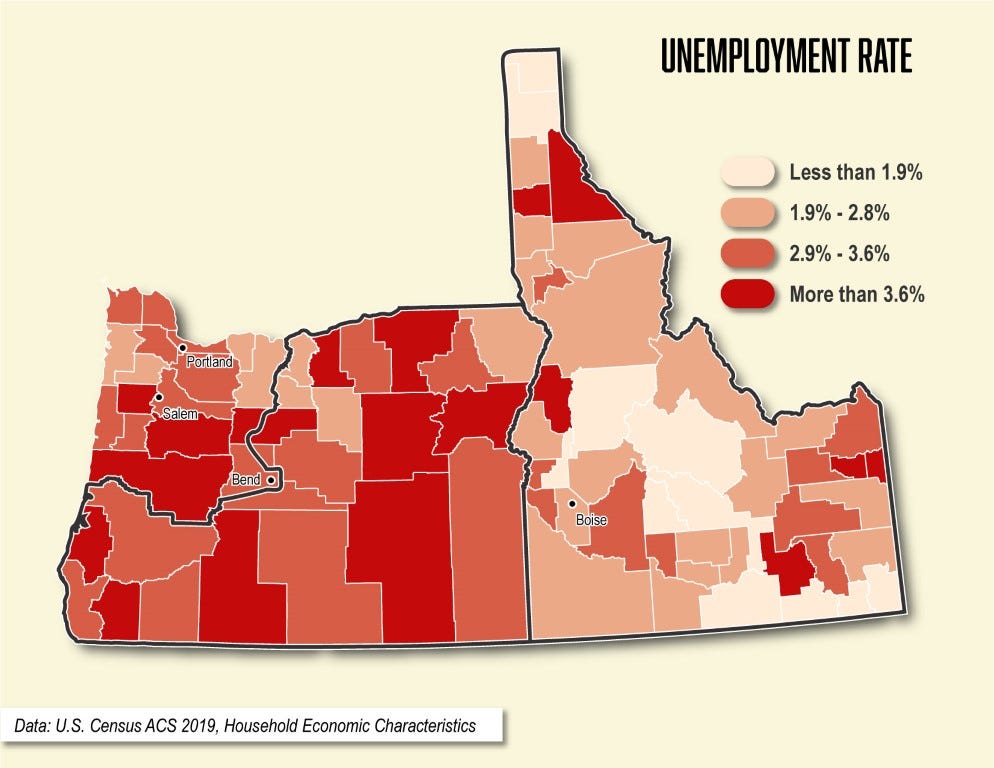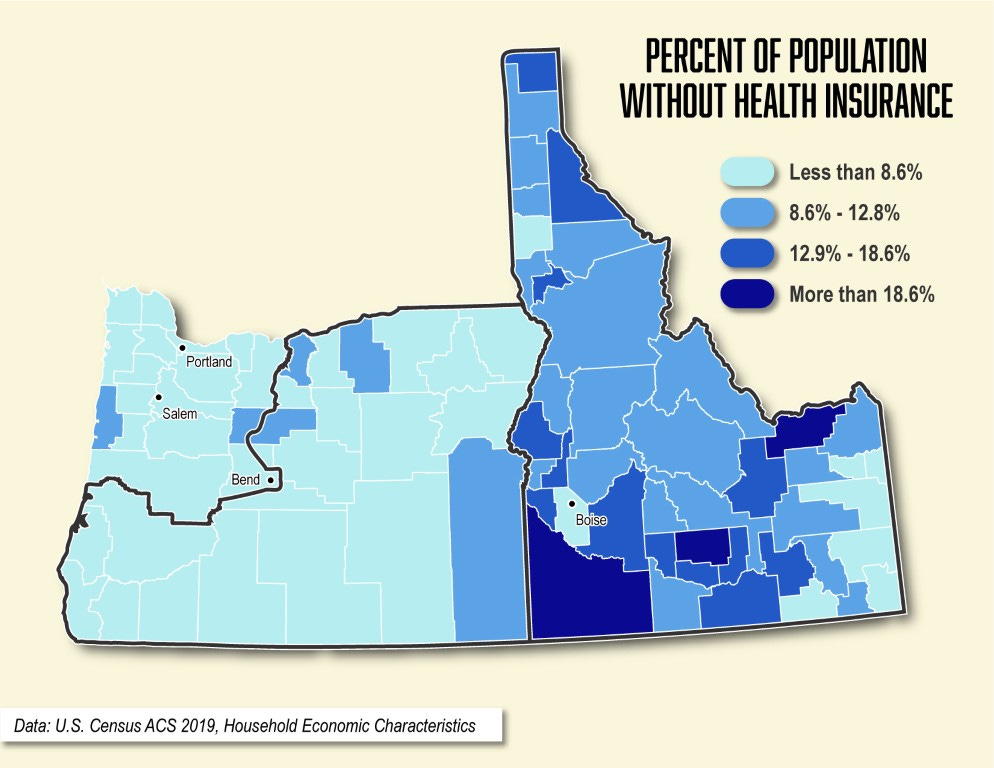Greater Idaho is a Terrible Idea
Data shows that moving from Oregon to Idaho would be bad for the people in almost every way
UPDATE! Ya know I’ve received some comments abut the quality of my data from various people. Which is fair. Always questions the maps and the map maker! But I wanted to respond to some that believe my analysis was trite (hi Dale!) or that I was cherry-picking data. I poured through a lot of census data and I didn’t change or manipulate it in anyway. I also looked for data that would be beneficial to these residents and didn’t come across any. But I recognize the elephant in the room: that this article and data are a sensitive subject to many and what’s happening in eastern Oregon is happening based on emotions and culture, not data. I should have been clearer about that up front and perhaps chosen a better title. Oops!
You’re welcome to go through the data yourself if you like: data.census.gov, search for Family Household Characteristics at the county level.
-
Welcome to the first ever newsletter on The Map Stack! My name is Geoff Gibson and I am a professionally trained geographer, cartographer, and urban planner. In a previous life I was also a journalist covering sports and tech. Every Monday morning you’ll be treated to a new interesting topic with fun new maps. All words are by me, maps and infographics are also created by me unless otherwise stated.
And now with that intro out of the way, let’s dig into today’s topic, the very first ever for this newsletter: Greater Idaho and why it’s such a terrible idea for the people living there.
If you’re from Oregon or Idaho, you might be casually aware of the Greater Idaho movement that is currently making the rounds in the eastern, more rural counties of Oregon. Or maybe you aren’t aware at all. Which is fine. It’s still a pretty small movement. However, in the past couple weeks, the movement has made quite a bit of regional news (and even some national news) when five counties voted to join the movement’s cause of leaving Oregon behind and joining Idaho. This would be in addition to the two counties that voted to move back in November 2020. All votes are non-binding, of course.
But let’s back up a bit.
What is Greater Idaho Exactly?
Greater Idaho is a conservative movement whose goal is to get about 19 counties, plus three partial counties of Oregon to move to Idaho, a far more conservative state with whom they feel there’s a stronger cultural connection. In some ways, I don’t begrudge the people who genuinely feel like this is their only option. The desire to move to somewhere more culturally “you” is something that has driven Americans everywhere to move around the country to find a place of their own. It’s partly why people came to America in the first place (not to delve too deep into the terrible history of colonization).
Who’s Behind the Greater Idaho Movement and Who Actually Wants It To Happen?
Good question. I’ve crawled through their website pretty extensively, and I can’t find much about the organization at large. They appear to be lead by a man named Mike McCarter - a lifelong Oregonian if he’s to be believed - but aside from that we don’t know who all is involved, their affiliations, or even where their money comes from (running these kinds of campaigns are not cheap after all).
As for which counties actually want to move to Idaho, these are the counties which have voted on it so far and their results.
As you can see there are now seven counties spread across eastern Oregon that have voted in favor of move to Idaho. If we boil it down a bit more, we can probably safely say that it’s a majority of conservatives who have voted in favor of it.
Why Do Eastern Oregonians Want to Join Idaho?
In a word: politics. Eastern Oregonians, much like rural communities across the country, tend to be far more conservative. And that’s exactly the impetus here for the movement. To illustrate this, here’s a map of the county results in Oregon for the 2020 election:
The backers of the Greater Idaho movement have been pretty intentional about where they are drawing their new border. They’ve even dissected three counties (Deschutes, Jefferson, and Wasco) so that the more liberal elements such as Bend, the Warm Springs reservation, and The Dalles remain in Oregon.
To quote the movement’s own Greater Idaho Proposal document:
These areas agree with Idaho on culture-war issues and policy issues. As the philosophy of the Left has unmoored itself from Biblical morality.
Woof. So make no mistake, despite everything I’m going to illustrate here, this is very much a decision being made for political and cultural reasons. And I don’t expect these maps to change anyone’s mind. That said…
Moving to Idaho Would Be Bad for Oregonians
Despite the politics involved, the data gives a preliminary picture of just how bad of an idea this would be.
A quick caveat on the data: Most of this data is from the 2019 American Community Survey U.S. Census data. This means it was from before the COVID-19 pandemic. As such, things have changed. However, given the topics at hand, I believe it still represents an accurate look at the overall benefits of being an Oregonian as compared to an Idahoan.
Alright, let’s dig in.
Unemployment
In 2019, the economy was doing pretty well overall. This is illustrated here by the really low unemployment rates across both states. However, there’s still quite a difference between Oregon and Idaho. In particular almost every county in Oregon that would make the jump to Idaho has a higher unemployment rate than the Idaho average. That likely wouldn’t change when moving to Idaho (at least not in the near term). What would change, however, are the unemployment benefits.
During COVID, the two states have the following unemployment benefits:
Oregon, 26 weeks of unemployment, $633/week maximum
Idaho, 20 weeks, $484/week maximum
For unemployed Oregonians, they would have 6 weeks fewer unemployment, and the maximum amount they were given would be decreased.
Health Insurance
This one is pretty stark. Idahoans currently have much higher rates of people without health insurance. This is partly because almost across the board, Oregon has a lower barrier to entry for their Oregon Health Plan Medicaid program. This is determined by percent as it relates to the Federal Poverty Line (FPL). In Oregon, you are simply allowed to make more money per year and still be eligible for medicaid than in Idaho. There are lots of caveats depending on variables such as age, children, etc. but the results are the same: it’s easier to have state health insurance in Oregon than it is in Idaho.
Minimum Wage
The current minimum wage in Oregon is $11.50/hour for non-urban areas. At a full-time job this would equate to $23,920/year. The current minimum wage in Idaho is $7.25/hour or $15,080 per year full-time. To illustrate how this affects Oregonians, I pulled up some data on service jobs for Oregon and Idaho. Service jobs are typically minimum wage (think McDonald’s cashier, or a gas station attendant) though not always. Still I felt like it was a good way to illustrate the potential issues at play here.
As the data shows, the counties in Oregon that would move, generally have a higher percent of their workers being within the service industry. Those workers who moved to Idaho could legally have their hourly wages decreased to Idaho’s minimum wage. That might not actually happen, but it’s feasible to believe. Certainly new employees hired after the move would earn less.
Marijuana
And finally, we have marijuana. In Idaho, marijuana is totally illegal. You can’t buy or use it recreationally or medicinally. This proves to be a big problem for Oregonians who might have grown used to buying and selling it. This map, I think, shows just how hard hit the industry would be and how many people would be impacted. Surprisingly, on a per capita level, Oregonians in eastern Oregon actually buy and sell more marijuana than in the Willamette Valley. Aside from a few counties which flatly do not allow it to be sold, the rest seem to enjoy the business and the recreational aspects of it. This would, of course, all go away the moment they joined Idaho which has shown no desire to join their neighbors in legalization.
Malheur County, the bottom right county, is actually a really interesting case because it’s by far the highest selling county on a per capita level. I don’t have a specific reason for this other than to suggest it could be due to its proximity to Boise. My hunch is that Boiseans go to Malheur County to purchase their marijuana.
More Maps
I don’t want to add too many more words to this, as it’s already kind of long, but I did gather some other maps and data that I found interesting.
Median Household Income
I think this just goes to show that perhaps this isn’t a good idea for Idaho as well. If Idaho were to agree to take these counties, they wouldn’t exactly be absorbing a large tax base as these are all fairly poor counties. This is a lot of land to absorb, with a lot of services to provide, with not enough added tax revenue.
Agriculture and Forestry Jobs
I also thought this one was interesting and has further implications for both Oregon and Idaho, but I just wasn’t able to fully dive into. However, we can see that the eastern Oregon counties are much more agrarian and natural resource dependent, which is in line with much of Idaho. This might be desirable for Idaho (I’m really not sure). However it just shows that there’s not a whole lot of growth potential here. Even most of the land in eastern Oregon is owned by the federal government. So natural resource extraction and exploitation would be fairly minimal.
I hope you enjoyed this dive into Greater Idaho. This is a multi-layered issue. I’m certainly not providing all the answers here, but I think the data does show that if you’re just an average person living in one of these counties, aside from ideology, you’re almost entirely better off continuing to live in Oregon.
Thanks for reading the first issue of The Map Stack! Next week’s topic will cover droughts as it looks like we’re headed for another big one. Sorry if that subject seems a bit too… dry. 😎














All of your points are the reason they want to leave. Oregon is forcing that crap on those people. Minimum wage, Healthcare, Legalized drugs, unemployment…. They are the results of the bad policies that they are trying to leave behind. Using that info as who they are is wrong. It’s what policies for the urban areas have forced on them.
Trite 'analysis'